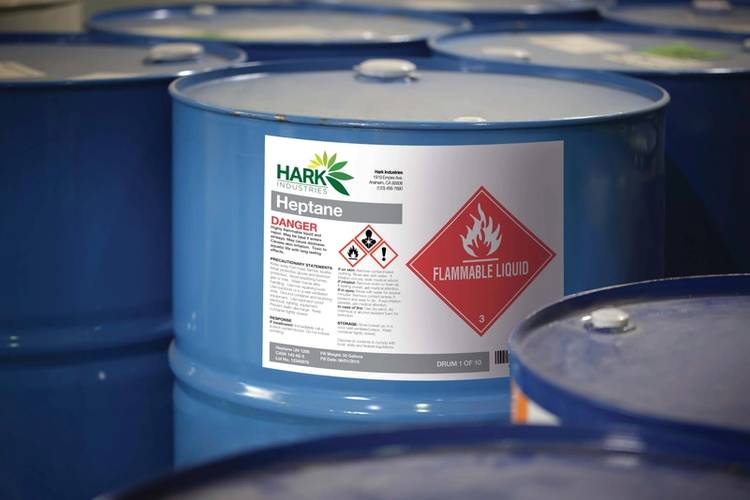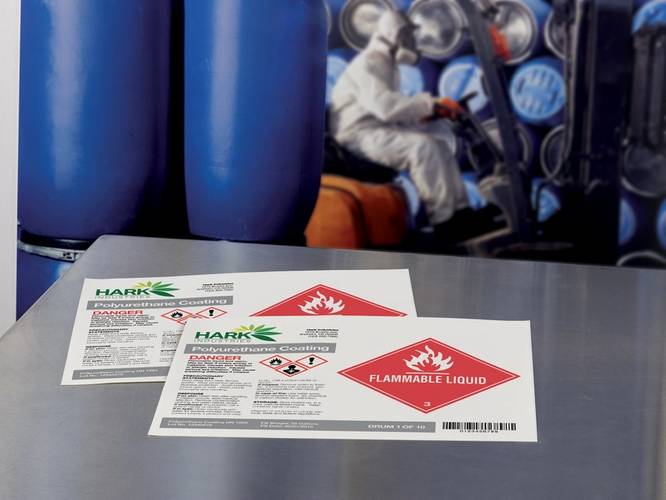Flexible, lower cost options enable shippers to print durable GHS labels on demand
For domestic and international shippers, now is the time to satisfy GHS freight label compliance. The “Globally Harmonized System” (GHS) was established by the United Nations to create a unified system for identifying and communicating hazardous chemicals. In the U.S., OSHA set a June 2015 deadline for chemical manufacturers to use GHS compliant labels, followed by a December 2015 deadline for distributors, and June 2016 deadline for end users.
Despite the harsh environments, extreme temperatures and rugged handling that freight is subjected to when shipped by land, air or sea, its GHS labels must not tear, fade, peel off or in any way become unreadable during transit.
Companies with chemicals exported by ocean freight must also comply with British Standard BS5609, a requirement for International Maritime Dangerous Goods (IMDG) certification. BS5609 Section 2 requires that the blank label and adhesive withstand a three-month, salt-water, submersion test, as well as artificial weathering tests of salt spray and sunlight. BS5609 Section 3 tests the printed label for abrasion resistance and print permanence, including artificial weathering (salt spray and sunlight) and tape removal. The test is conducted on labels printed with specific printers.
On each GHS label, six specific items of data are required: Product Name or Identifier; Hazard Statement; Signal Word; GHS Pictogram symbols; Precautionary Statement; and Supplier Information. In place of the familiar black and white pictogram symbols previously used in safety labeling, GHS labels now require pictogram symbols that convey hazard information with a red diamond border.
Implementing GHS labeling can seem daunting, particularly to small to mid-sized shippers, but does not have to be. While large shippers can hire integrators to automate GHS software with a bank of printers tied into high-end ERP infrastructure, small and medium sized shippers do not require this approach. Instead of investing in costly dedicated printer/label/software systems, such shippers are easing the transition to GHS freight label compliance. More are turning to flexible, lower cost options, such as print-on-demand, shipping-grade GHS labels.
While Avery, for instance, has been a leading office label brand for decades, it has recently developed domestic and international shipping-grade labels designed not only to be GHS compliant but also BS5609 Section 2 and 3 certified, such as its UltraDuty GHS Chemical Labels. The durable synthetic labels are chemical resistant, tear resistant, abrasion resistant, and constructed with a waterproof, marine-grade adhesive.
Unlike typical labels, which crack and harden in harsh conditions, they are UV and extreme temperature resistant with 2+ years of outdoor UV life. To withstand the rigors of shipping, they can be applied as low as 10° F, and endure temperatures from -20° F to 220° F.
“Becoming GHS and BS5609 label compliant is a competitive advantage to shippers over those who delay meeting these important domestic and international standards,” says Glen Markham, Vice President of Business Development at RightAnswer.com, Inc., a chemical compliance and information specialist.
“When handling dangerous chemicals, shippers cannot afford to have the labels fall off or fail for any reason,” adds Markham. “Compliant labeling not only helps to ensure the cargo is properly handled all the way to its destination, but also that it can be promptly, appropriately cleaned up if there is any spillage incident. This protects the environment, the safety of cargo handlers, the reputations of shippers and their clients, and reduces the risk of litigation and bad public relations.”
Markham notes that remaining GHS and BS5609 label compliant depends on the durability of the appropriate label substrate, getting the label content right, and effective document management.
While selecting labels that are sturdy enough to meet required standards is vital to shippers, so is printing them on printers that produce compliant freight labels. Though most label companies only supply the labels and leave it up the shipper to use them with compliant printers, some test the label with the printer.
For instance, Avery certifies that certain label and printer combinations are GHS and BS5609 compliant. For labels that meet required BS5609 Section 3 certification, shippers must select specific printers and labels that are designed to work together to pass certification. Visit www.avery.com/vgnfiles/images/industrial/approved_printers.htm for a list of printers that are BS5609 Section 3 certified with Avery UltraDuty GHS Chemical Labels.
To help small and medium sized shippers print such labels on demand, some companies provide label-printing software along with their labels.
Avery, for example, is one of the only companies that provide such software at no cost. The Avery Design & Print GHS Wizard makes it easy for employees to create and print their own GHS and BS5609 Section 3 certified labels from pre-designed templates or to create them step-by-step on demand at their desk. Most employees will find the process intuitive, since it resembles creating an office document from pre-designed templates.
The free software includes all the pictograms and GHS compliant statements needed for GHS labeling; easy insertion of company logo or other images; customizable text; simple generation of 18 types of barcodes; and a sequential numbering feature to add lot numbers or other variable data.
No download is required since the software operates from Avery’s website (www.avery.com/GHS), and GHS labels can be securely saved online or to a computer.
The GHS labels are available in a range of sizes to fit drums and containers. They can be applied to a variety of surfaces such as metal, plastic, polycarbonate, painted surfaces, and more. Similar to Avery’s office labels, the GHS labels retain Easy Peel, smudge-free, and jam-free capability.
To help shippers stay compliant for GHS and other regulatory situations, Avery has also partnered with RightAnswer. Through a portal in Avery’s website, RightAnswer offers comprehensive online access to over 100 proprietary, government, and Environmental Health and Safety (EHS) data sources with over 11 million documents covering more than 400,000 chemical substances, all integrated and available through a single interface.
“For shippers that keep asking dock, shipping and EHS managers to do more with less, Avery’s partnering with RightAnswer can help them stay not only GHS and BS5609 label compliant, but also up to date on the chemical issues they’re concerned about,” says Markham. “It’s an online one-stop chemical compliance and information solution that’s offered at a discount through the Avery website portal.”
While postponing GHS and BS5609 freight label implementation is no longer an option for shippers, complying with such regulation can be as easy as turning to flexible, lower cost, print-on-demand, shipping-grade labels.
About the author
Del Williams is a technical writer based in Torrance, Calif.















